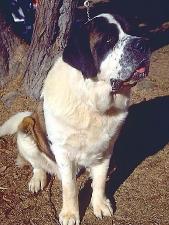St. Bernard

Register for a free My Pets account to feature you pet’s picture here!
- Dog Breed Group
- Working Dogs
- Origin of Breed
- Switzerland as a rescue dog.
- Life Expectancy
- 10 to 12 years
- Color
- red-brown and white or brindle and white
- Coat
- Either shorthaired (short, thick, and dense) or longhaired (medium length and slightly wavy. Both have undercoat.
- Exercise Needs
- Moderate energy level. Requires long walks. a puppy should not have to much activity until the bones are well-formed and strong.
- Temperament
- Sensible, gentle, and patient. Highly intelligent and easy to train. Because of enormous size, should be trained in early puppyh
- Good with Children
- Usually fine with other animals and children. Sheer size makes it a good watchdog.
- Grooming Needs
- Heavy shedder during spring and fall. Requires 3 brushings per week.
- Average Size - Male (in)
- > 27.5
- Average Size - Female (in)
- > 25
- Average Weight - Male (lbs)
- 110 - 200+
- Average Weight - Female (lbs)
- 110 - 200+
- Health Issues
- Heavy drooler. They are particularly prone to hip dysplasia and heart disease. It may also suffer from epilepsy, skin problems, v
- Living Conditions
- Does best in suburbs or country but can adapt well to urban living if given plenty of space and exercise. Thrives in colder clim
Breed Description
A powerfully built, muscular dog with a massive head and drooping ears, the Saint Bernard is descended from the Molossian Mastiff. Wanting a dog which would work as guards and mountain guides the monks of the ancient Hospice du Grand Saint Bernard in the Swiss Alps developed this breed. Probably descended from mastifflike dogs that were introduced from Asia to Europe by the Romans, the St. Bernard appears to have been brought to the hospice in the late 17th century. The most famous of the hospice dogs was Barry, who reportedly saved more than 40 people before his death in the early 1800s. They became famous for rescuing travelers and climbers on the Swiss Alps. In 1830 Newfoundland blood was introduced in an attempt to give the breed added size and vitality. Up until that time all Bernard's were short-coated.
Breed Infobits
The Saint Bernard is also known as the Alpine Mastiff and the St. Bernhardshund.
Saint Bernards are credited with saving the lives of some 2,500 people in 300 years of service.
Disclaimer: Pets.ca cannot be responsible for the accuracy of the above presented information. Please double check all information prior to making any decisions about purchasing this or any breed. If you think we have made an error with some of the information presented here, please e-mail us at breedprofiles@pets.ca.






